|
 The partners billed the industry's biggest ever tie-up as a merger
of equals, under which Lafarge shareholders receive one Holcim share
for every Lafarge held and Holcim investors end up with 53 percent
of the new group. The merged business will be based in Switzerland
and listed in Zurich and Paris. The partners billed the industry's biggest ever tie-up as a merger
of equals, under which Lafarge shareholders receive one Holcim share
for every Lafarge held and Holcim investors end up with 53 percent
of the new group. The merged business will be based in Switzerland
and listed in Zurich and Paris.
As the two biggest listed companies in the sector already, with
operations in 90 countries, the pair expect to face antitrust
scrutiny in 15 jurisdictions and to sell some 5 billion euros ($6.85
billion) of assets to persuade competition regulators to allow the
creation of LafargeHolcim.
The deal will give the group a market value of close to $60 billion.
It will help it slash costs, trim debt and better cope with the
soaring energy prices, tougher competition and weaker demand that
have hurt the sector since the 2008 economic crisis.
Analysts said it would bring together Holcim's strength in marketing
with Lafarge's innovative edge and could generate substantial
savings — provided that necessary asset sales, which may take
several years, do not deplete that potential too much.
"The road to merger clearance will be a long, complex and uncertain
one," said David Anderson at the Berwin Leighton Paisner law firm.

Antitrust enforcers will take a hard look at the deal because of a
history of collusion in the cement industry, said Herbert Hovenkamp,
who teaches antitrust law at the University of Iowa's College of
Law.
Lafarge was fined by European antitrust regulators for price-fixing
in 1994 and in 2002. The European Commission opened another
investigation into several cement producers in December 2010, and
Lafarge and Holcim are among companies being probed.
Some analysts believe regulators could block the merger, although
most expect the deal to go through in the end.
Two-thirds of divestments are expected to affect Western Europe, but
there are also overlapping operations in India, China, Canada and
Brazil, Lafarge Chief Executive Officer Bruno Lafont told reporters.
He is set to run the combined group.
In afternoon trade, both firms' shares were up around 0.5 percent,
trimming earlier gains. At Thursday's close, before news broke on
Friday that the two were in merger talks, one share in Holcim was
worth 4.4 percent more than one in Lafarge.
Sources close to the talks, which began in earnest in January, said
the process had been complex because both companies have
shareholders with very large individual stakes, with whom a parallel
set of negotiations had to be conducted.
Core investors had backed the deal, the companies said.
The negotiations, code-named "Cities" to reflect the theme of
construction, was helped by conducive market conditions and the fact
that the companies were similar in size.
Lafarge and Holcim said they expected total annual savings from
joining forces of 1.4 billion euros over three years, thanks to
economies of scale, better operational efficiency and lower
financing costs.

EMERGING MARKET PUSH
The deal comes after both companies took on big debts in the past
decade to expand in emerging markets, where rapid urbanization has
fed demand for building materials. The bursting of the U.S. housing
bubble and the euro zone debt crisis caused markets to slump,
however, and they both embarked on cost-cutting drives and started
shedding assets to trim debt.
A combined LafargeHolcim will be better able to fend off growing
competition from rivals in emerging markets, such as Mexico's Cemex
<CMXCPO.MX> and China's Anhui Conch <600585.SS>, which last year
overtook Lafarge as the world's top cement maker by volume, although
not in revenue nor market value.
"It's really an offensive deal, a reconfiguration to have a group
with a stronger presence in faster growing markets," said one source
close the merger talks.
According to Aurel BGC analysts, Lafarge and Holcim together sold
around 275 million tons of cement last year — nearly three times
more than their closest listed rival, Germany's HeidelbergCement <HEIG.DE>.
[to top of second column] |

The groups complement each other geographically, company executives
said, with Lafarge stronger in Africa and Holcim stronger in Latin
America. Emerging markets will account for 60 percent of sales; no
country will represent over 10 percent.
"LafargeHolcim will be present worldwide in a balanced way," said
Lafont. He stressed that while its headquarters would be in
Switzerland, it would have roots across Europe.
"If we can't create global champions in Europe, then we're defeated.
And we can only create European champions if we manage to go beyond
traditional frontiers," Holcim Chairman Rolf Soiron added at a joint
news conference in Paris.
DIVESTMENTS
Lafarge and Holcim confirmed that they would sell businesses worth
10 to 15 percent of the group's earnings before interest, tax,
depreciation and amortization (EBITDA) to satisfy antitrust concerns — or about 5 billion euros in total.
"We are immediately going to start discussions with the European
Commission and other competition regulators in a constructive
spirit," Lafont said, adding the group would set up a committee
specifically devoted to divestments.
The merger has been discussed with France's Socialist government and
there will be no plant closures tied to the deal, Lafont said. The
group's research center will be in France, Lafarge's home country,
and there would be only a very limited impact on jobs there, he
stressed.
Analysts cite France, Germany, the Czech Republic, Romania, Serbia,
Canada, Morocco and the Philippines as areas where antitrust
authorities would press for the biggest disposals.

The U.S. cement market is not concentrated, so U.S. antitrust
regulators will likely review the deal's effects on regions as small
as a few counties, said Andre Barlow, an antitrust expert with the
law firm Doyle, Barlow and Mazard PLLC.
Cement is a low-value, heavy product, so markets tend to be
geographically small.
All signs point to the likelihood that the companies and U.S.
regulators will come to an agreement on asset sales that allows the
deal to close, Barlow said.
Managers said synergies at EBITDA level were made up of 200 million
euros at operational level, 340 million in purchasing, 250 million
in sales and 200 million in innovation. On top of this, the
companies see 200 million euros of savings on financial costs and
200 million for investments.
Both companies said the transaction had won the support of core
shareholders and was expected to close in the first half of 2015.
They both have high-profile billionaire shareholders -Belgium's
Albert Frere, Egypt's Nassef Sawiris, Switzerland's Thomas
Schmidheiny and Georgian-born Filaret Galchev.
Frere's holding company Groupe Bruxelles Lambert <GBLB.BR>, which
has a 21 percent stake, said it would support the deal and would
hold about 10 percent in the combined group after the transaction
was completed.
($1 = 0.7303 Euros)
(Additional reporting by James Regan and Andrew Callus in Paris,
Robert-Jan Bartunek and Foo Yun Chee in Brussels, Diane Bartz in
Washington, and Anjuli Davies and Sophie Sassard in London; editing
by Will Waterman and Alastair Macdonald)
[© 2014 Thomson Reuters. All rights
reserved.] Copyright 2014 Reuters. All rights reserved. This material may not be published,
broadcast, rewritten or redistributed.
 |